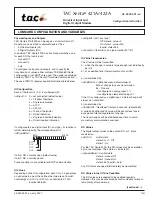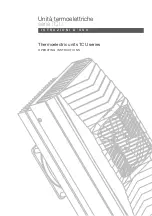
5 - Effects
Core Effects Descriptions
82
Creative Professional
Parameters
Threshold
When the input signal rises above the level set by the Threshold parameter, the Gate is
triggered to turn on and go from its maximum gain reduction level up to 0dB gain. The
turn-on threshold is adjustable anywhere between -70dB and 0dB (below the PatchMix
nominal operating point of -12dBFS.)
One of the keys to the smooth operation of the Gate is that the input Threshold level
that turns on the Gate is always higher than the level that shuts off the gate.
This means
that the input signal level must descend substantially below the Threshold in order
to turn off again.
This difference between turn-on and shut-off levels, or the hysteresis, is 10dB. That
means that if the Threshold is -30dB, the signal level must fall to -40dB before the Gate
will begin to shut off.
Release Time
This parameter controls the time, in milliseconds, that is required for the Gate to shut
off. More specifically, this is the time that will be required for the Gate control signal to
go from unity gain at 0dB down to the Max Gain Reduction level.
The optimum value for the Release time is dependent on the program material as well
as the effect you're trying to achieve. Optimum Release time is also highly dependent
upon the settings of the Threshold and Max Gain Reduction parameters.
In general, times less than about 10 msec are prone to cause clicks in the output, while
times longer than 30 msec may make the gating effect obvious if the background signal
being gated out is very noisy.
Max Gain Reduction
This parameter sets the attenuation that will be applied to the signal when the Gate is
shut off. The Gate control signal will swing between 0dB and this value as the Gate
turns on and shuts off.
To perform a strict “gating” operation, Max Gain Reduction would normally be set to -
infinity in order to completely silence the output of the Gate.
However, there are good reasons to set Max Gain Reduction to something less drastic
than infinite attenuation. Sometimes the silence between gated signals is “too quiet” -
especially when the signal represents a solo vocal or instrument, where the complete
lack of any sound between voiced segments sounds unnatural. For these applications,
setting Max Gain Reduction somewhere between -20dB and -40dB is more appropriate.
In tandem with a high Threshold, Max Gain Reduction can also be set to very modest
values like -5 or -10dB in order to add a subtle “punch” enhancement to transients.
This has an effect similar to an expander, where the attack transients which exceed the
Threshold stand out by 5 or 10dB above the normal signal (you can make up for that 5
or 10dB attenuation by using a trim pot or boosting the channel strip gain after the
Gate.)
Lookahead
By default, the Gate effect uses a fixed 1 millisecond lookahead to avoid clipping off
the leading edge of signal transients when the Gate turns on. However, this is actually
implemented by adding a 1 millisecond delay to the signal through the gate. For appli-
cations where this additional 1 millisecond latency is a problem, the Lookahead can be
turned Off.
















































